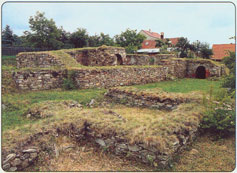|
From the history of Kralice

Undulating landscape with woods and small fields, romantic valleys of the Oslava and
Chvojnice rivers, this is the countryside of the old village of Kralice. Its name comes
- according to the historian Vlasta Fialová - from the retinue of the first Czech
King Vratislav watching over the sovereignty of the ruler. Until 1310 when Kralice
is first mentioned in written sources, the settlement of the place is documented with
rare archaeological findings, especially with slavonic ceramics. Direct evidence
of the past of Kralice are the remains of the fortified settlement and the
St.Martin-Church dating back to the 2nd half of the 14th century. Conserved gothic
wall paintings and insriptions from 1580 show the typical decoration of Czech Brethren
churches in the 16th century. The stone tower played an important defensive role compared
with the fortified settlement being protected with a mere palisade or fence.
The residence of the local gentry was built by the lords of Kralice in the middle of the 14th century. The initial gothic fortified settlement was remodelled into a Renaissance chateau. The mighty Žerotín family were one of to the main political supporters of the Evangelic and Czech Brethren nobility in Moravia, that is why the secret printing house of the Czech Brethren was transfered from Ivančice to Kralice in 1578. Until 1619 more than 70 books were printed there including the famous Czech Bible in six volumes known as the Kralice Bible.
Thanks to the systematic excavations undertaken from 1956-1971 by Dr. Vlasta Fialová, the basic architectonic shape of the fortified settlement of Kralice could be reconstructed. The building with several storeys and a square courtyard with arcades was a typical product of the Renaissance. It disappeared after 1628 due to the events of the 30 year war. Findings of type-metal and a large amount of types and tools, bindings and staples proved the existence of a printing workshop. The Kralice fortified settlement was for some time a cultural and literary centre of the Czech Brethren, because the printing house was connected with a group of scholars, theologists and linguists working on the commentary and Czech translation of the bible.
The residence of the local gentry was built by the lords of Kralice in the middle of the 14th century. The initial gothic fortified settlement was remodelled into a Renaissance chateau. The mighty Žerotín family were one of to the main political supporters of the Evangelic and Czech Brethren nobility in Moravia, that is why the secret printing house of the Czech Brethren was transfered from Ivančice to Kralice in 1578. Until 1619 more than 70 books were printed there including the famous Czech Bible in six volumes known as the Kralice Bible.
Thanks to the systematic excavations undertaken from 1956-1971 by Dr. Vlasta Fialová, the basic architectonic shape of the fortified settlement of Kralice could be reconstructed. The building with several storeys and a square courtyard with arcades was a typical product of the Renaissance. It disappeared after 1628 due to the events of the 30 year war. Findings of type-metal and a large amount of types and tools, bindings and staples proved the existence of a printing workshop. The Kralice fortified settlement was for some time a cultural and literary centre of the Czech Brethren, because the printing house was connected with a group of scholars, theologists and linguists working on the commentary and Czech translation of the bible.
Last modified: